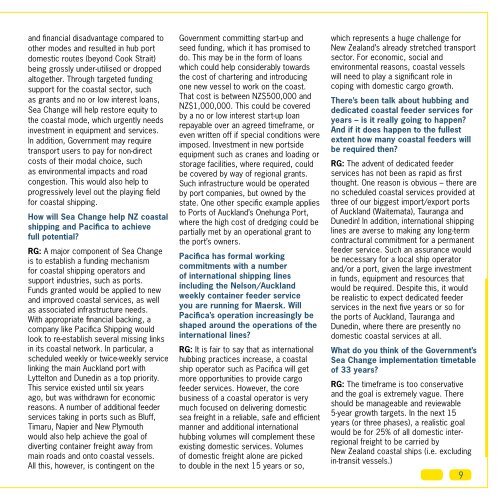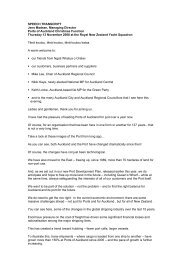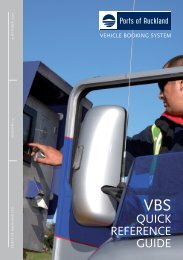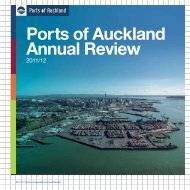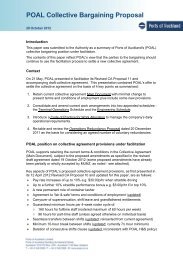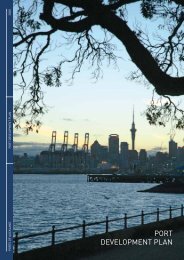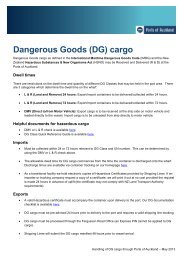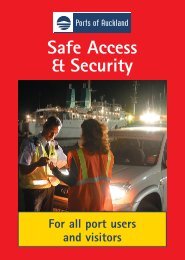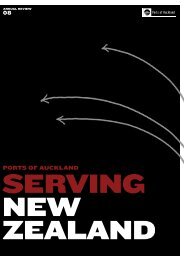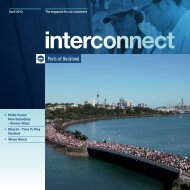Download publication - Ports of Auckland
Download publication - Ports of Auckland
Download publication - Ports of Auckland
- No tags were found...
Create successful ePaper yourself
Turn your PDF publications into a flip-book with our unique Google optimized e-Paper software.
and financial disadvantage compared toother modes and resulted in hub portdomestic routes (beyond Cook Strait)being grossly under-utilised or droppedaltogether. Through targeted fundingsupport for the coastal sector, suchas grants and no or low interest loans,Sea Change will help restore equity tothe coastal mode, which urgently needsinvestment in equipment and services.In addition, Government may requiretransport users to pay for non-directcosts <strong>of</strong> their modal choice, suchas environmental impacts and roadcongestion. This would also help toprogressively level out the playing fieldfor coastal shipping.How will Sea Change help NZ coastalshipping and Pacifica to achievefull potential?RG: A major component <strong>of</strong> Sea Changeis to establish a funding mechanismfor coastal shipping operators andsupport industries, such as ports.Funds granted would be applied to newand improved coastal services, as wellas associated infrastructure needs.With appropriate financial backing, acompany like Pacifica Shipping wouldlook to re-establish several missing linksin its coastal network. In particular, ascheduled weekly or twice-weekly servicelinking the main <strong>Auckland</strong> port withLyttelton and Dunedin as a top priority.This service existed until six yearsago, but was withdrawn for economicreasons. A number <strong>of</strong> additional feederservices taking in ports such as Bluff,Timaru, Napier and New Plymouthwould also help achieve the goal <strong>of</strong>diverting container freight away frommain roads and onto coastal vessels.All this, however, is contingent on theGovernment committing start-up andseed funding, which it has promised todo. This may be in the form <strong>of</strong> loanswhich could help considerably towardsthe cost <strong>of</strong> chartering and introducingone new vessel to work on the coast.That cost is between NZ$500,000 andNZ$1,000,000. This could be coveredby a no or low interest start-up loanrepayable over an agreed timeframe, oreven written <strong>of</strong>f if special conditions wereimposed. Investment in new portsideequipment such as cranes and loading orstorage facilities, where required, couldbe covered by way <strong>of</strong> regional grants.Such infrastructure would be operatedby port companies, but owned by thestate. One other specific example appliesto <strong>Ports</strong> <strong>of</strong> <strong>Auckland</strong>’s Onehunga Port,where the high cost <strong>of</strong> dredging could bepartially met by an operational grant tothe port’s owners.Pacifica has formal workingcommitments with a number<strong>of</strong> international shipping linesincluding the Nelson/<strong>Auckland</strong>weekly container feeder serviceyou are running for Maersk. WillPacifica’s operation increasingly beshaped around the operations <strong>of</strong> theinternational lines?RG: It is fair to say that as internationalhubbing practices increase, a coastalship operator such as Pacifica will getmore opportunities to provide carg<strong>of</strong>eeder services. However, the corebusiness <strong>of</strong> a coastal operator is verymuch focused on delivering domesticsea freight in a reliable, safe and efficientmanner and additional internationalhubbing volumes will complement theseexisting domestic services. Volumes<strong>of</strong> domestic freight alone are pickedto double in the next 15 years or so,which represents a huge challenge forNew Zealand’s already stretched transportsector. For economic, social andenvironmental reasons, coastal vesselswill need to play a significant role incoping with domestic cargo growth.There’s been talk about hubbing anddedicated coastal feeder services foryears – is it really going to happen?And if it does happen to the fullestextent how many coastal feeders willbe required then?RG: The advent <strong>of</strong> dedicated feederservices has not been as rapid as firstthought. One reason is obvious – there areno scheduled coastal services provided atthree <strong>of</strong> our biggest import/export ports<strong>of</strong> <strong>Auckland</strong> (Waitemata), Tauranga andDunedin! In addition, international shippinglines are averse to making any long-termcontractural commitment for a permanentfeeder service. Such an assurance wouldbe necessary for a local ship operatorand/or a port, given the large investmentin funds, equipment and resources thatwould be required. Despite this, it wouldbe realistic to expect dedicated feederservices in the next five years or so forthe ports <strong>of</strong> <strong>Auckland</strong>, Tauranga andDunedin, where there are presently nodomestic coastal services at all.What do you think <strong>of</strong> the Government’sSea Change implementation timetable<strong>of</strong> 33 years?RG: The timeframe is too conservativeand the goal is extremely vague. Thereshould be manageable and reviewable5-year growth targets. In the next 15years (or three phases), a realistic goalwould be for 25% <strong>of</strong> all domestic interregionalfreight to be carried byNew Zealand coastal ships (i.e. excludingin-transit vessels.)


